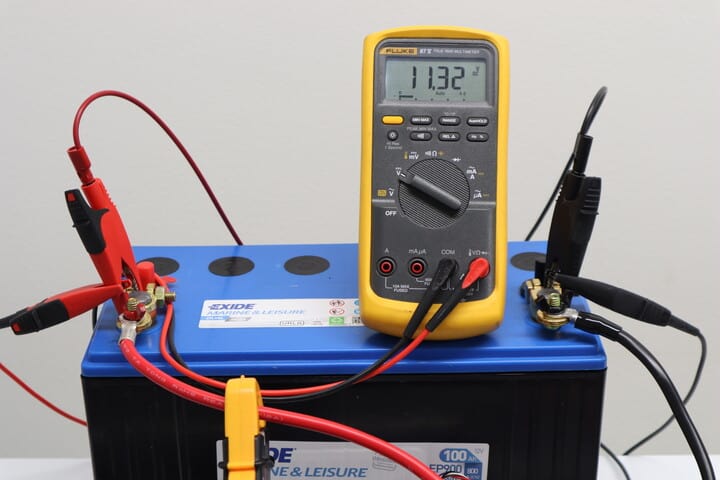When using or charging an AGM battery, you often need to know how full the battery is – or in technical terms, its State of Charge (SoC). This page gives you charts to estimate SoC from a multimeter voltage reading. (See end of article for terminology.)
AGM SoC vs. No-Load Voltage
The simplest way to determine the State of Charge of an AGM battery is to measure the battery no-load or open-circuit voltage – this is the voltage across the battery poles when no load is connected.
| 12V AGM SoC VS. NO-LOAD VOLTS State of Charge (SoC) | Open-circuit voltage* | Notes |
|---|---|---|
| 100% | 12.7…13.0 V | varies |
| 80% | 12.5…12.7 V | |
| 60% | 12.3…12.5 V | recharge recommended |
| 40% | 12.0…12.2 V | |
| 20% | 11.8…12.0 V | |
| 10% | 11.7…11.9 V | stop discharge |
| 0% | 11.4…11.6 V | permanent damage |
| *after 12h rest |
NB. The no-load voltage takes HALF A DAY to stabilize!
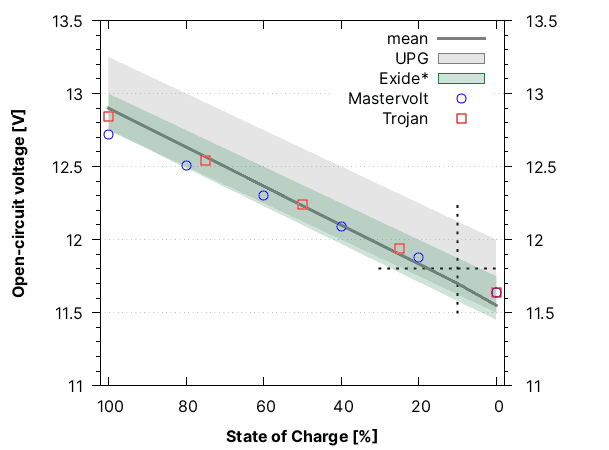
AGM SoC vs. Under-Load Voltage
The State of Charge of an AGM battery can also be estimated from its under-load voltage, i.e. the voltage while connected to a load.
| 12V AGM State of Charge | Under-load voltage*, @ 0.01C discharge | Under-load voltage**, @ 0.1C discharge | Notes |
|---|---|---|---|
| 100% | 12.9V | 12.7V | |
| 80% | 12.6…12.7V | 12.5V | |
| 60% | 12.4…12.5V | 12.3…12.4V | recharge recommended |
| 40% | 12.1…12.3V | 11.9…12.1V | cut-off |
| 20% | 11.8…12.0V | 11.6…11.8V | |
| 10% | 11.6…11.8V | 11.2…11.3V | “empty” (FDV); stop discharge |
| 0% | 11.3…11.5V | 10.2V | |
| *after 20 min loading | **after 10 min loading |
The under-load voltage is advantageous in that it stabilizes fast and allows State of Charge estimation online while the battery is used. The downside is that the under-load voltage depends on the load level.
AGM Empty Voltage
Final discharge voltage (FDV) is the under-load voltage at which an AGM battery is practically empty; it corresponds to 0…10% SoC. This voltage is sometimes called the end voltage, and discharge should be stopped at this voltage at latest.
| AGM BATTERY EMPTY VOLTS Discharge rate | Final discharge voltage | Notes |
|---|---|---|
| 0.01C | 11.7V | ~no-load |
| 0.1C | 10.7…11.1V | |
| 0.3C | 10.3…10.8V | |
| 0.5C | 9.8…10.3V | |
| 1C | 9.5…10.0V | |
| 3C | 7.8…9.4V | large variation |
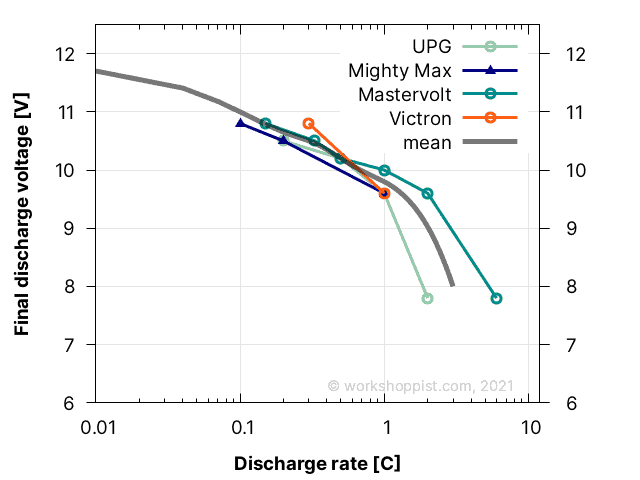
Final discharge voltage is the most important under-load voltage – it is something you (or your load controller) must know, or otherwise your AGM batteries will have a very short life.
What are the charts based on?
The voltages in the charts are based on my own measurements and a survey of manufacturer data. I have found most charts on the Internet inaccurate or confusing (load or no-load?) and had to compile my own.
Manufacturer data is available on no-load voltages are available for many AGM brands; under-load voltages are typically limited to the final discharge voltage (FDV). Some data was provided by at least Mastervolt, Mighty Max, Trojan, UPG and Victron.
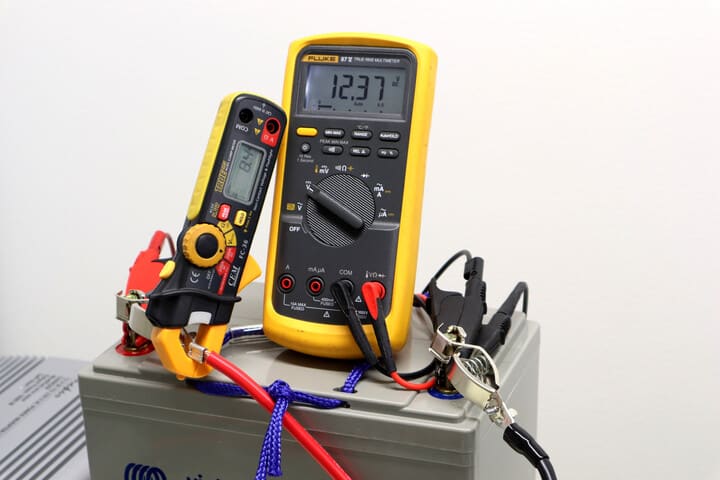
AGM Cut-off Voltage?
Cut-off voltage or low-voltage cut-off refers to the voltage at which the battery discharge is stopped voluntarily.
In normal cycle use, the cut-off voltage should be set much higher than the final discharge voltage (FDV). Typical cut-off voltages at moderate load (0.1C, ~5…10A for car/truck battery) would be 11.9V to 12.3V corresponding to 40…60% SoC. Not discharging all the way down to FDV extends your battery life considerably.
Voltages to remember
The most important AGM battery voltages you should remember are:
- FULL AGM (100% SoC) – should read 12.7V to 13.0V without load
- HALF-FULL AGM (50% SoC), should be 12.1V to 12.3V (i.e. slightly above nominal voltage)
- FLAT AGM (10% SoC) reads 11.7V to 11.9V without load
NB. Trying to squeeze out the last 10% damages the battery permanently, and is not worth it outside emergencies. Instead, you should recharge such a battery ASAP.
6V or 24V AGM batteries?
For 6-volt or 24-volt AGM batteries, respectively, simply divide or multiply the voltage levels given on this page by two.
Notes on the data
The voltage vs. SoC data is not 100% accurate for all AGM units. There are significant differences between AGM brands and some variation due to individual battery use history, wear and temperature. (UPG actually gives a whopping 0.5V uncertainty to the voltages at all States of Charge.)
The No-load and Under-load Voltage Charts will give you only a rough indication of the State of Charge: as a rule of thumb, add a +-10% uncertainty to the SoC value you estimate.
Stabilization time
Make sure that the AGM battery voltage is stabilized before you take a reading.
The no-load voltage may take 12 hours or more (!) to reach the proper level after charging or discharging. Mastervolt specifies a 12-hour rest period, but my own measurement showed at least 50 mV change still between 12 and 22 hours after disconnecting charger from a 12-V 100Ah Exide Marine AGM – see graph below.
Some guidelines for AGM voltage stabilization times from my personal experience:
- NO LOAD: up to a day to creep to within 0.1 V of the final voltage; Mastervolt specifies 12 hours before taking a reading
- Slow discharge (0.01…0.02C): 10 minutes
- Moderate discharge (0.1C): under 5 minutes
Apart from the 12h for the open-circuit voltage, I have not found any manufacturer data on how long you should wait for AGM battery voltage to stabilize.
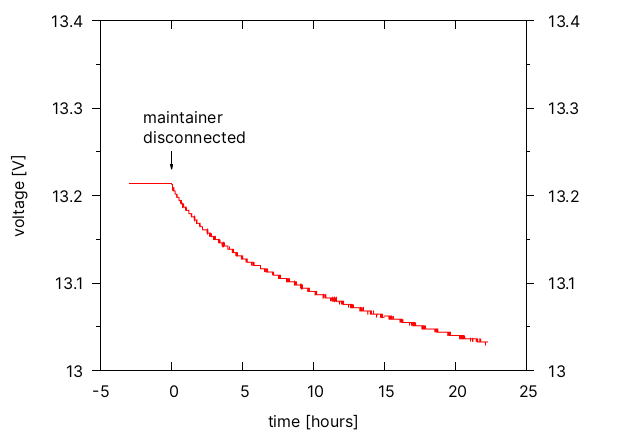
No time to wait?
Waiting 12 hours to get a proper measurement of the open-circuit voltage is obviously not always practical.
Fortunately most of the stabilization happens in the first 10 minutes after disconnecting a charger or a load. So if you are in a hurry, there is a shortcut to be taken: see where the voltage goes in the first 10 minutes, and extrapolate 0.1V to 0.2V to the same direction to get an estimate of the stabilized voltage.
Not waiting for the real stabilized voltage reading will add a bit to the uncertainty in estimating the State of Charge. However, it’s often the best you can do.
State of Charge (SoC) explained
The State of Charge basically means how much charge the battery contains relative to its maximum capacity; it means how full the battery is.
State of Charge is usually expressed as a percentage: a 100% SoC means a full battery, a state of charge of 50% tells you the battery is half full, and around 10% is practically flat.
Typical AGM SoC
In general, AGM batteries stay in the best condition when kept as close to 100% SoC as possible all the time. A typical cycle use case would see an AGM battery SoC will go between 100% and 70%, for example, in an alternating charge–discharge sequence.
Discharging to 50% SoC or below is called a deep cycle – such cycles wear the battery, and should be avoided if possible. Discharging below 10% is very harmful to an AGM battery, and makes sense only in emergencies.
Why does SoC matter?
State of Charge is the key metric in AGM battery operation. You need to know the SoC to:
- Tell the remaining runtime of your boat or RV house power system
- Know when to stop discharge to avoid battery damage
- Know when your AGM batteries have reached full charge
State of Charge vs. Depth of Discharge (DoD)
Battery Depth of Discharge (DoD) is a metric parallel to the State of Charge. Simply put, the Depth of Discharge tells how much of full charge you have drained out of the battery, while State of Charge tells how much is left.
The relation of Depth of Discharge (DoD) to the State of Charge (SoC) can be expressed as
DoD = 100% – SoC [%]
Thus a fully charged battery at 100% SoC has 0% Depth of Discharge, and a practically flat one at 10% SoC has 90% Depth of Discharge.
AGM battery State of Charge Q&A
What voltage is a fully charged AGM battery?
An fully charged 12-volt AGM battery should typically have a voltage of 12.7V to 13.0V when not connected to a load or a charger – such a voltage is called the open-circuit voltage. Similarly, 6V and 24V AGM batteries should have voltages of 6.35…6.5V and 25.4…26V, respectively. Note that these readings assume the battery has rested at least 12h after charging. For more info, see the open-circuit voltage chart above.
If a fully charged 12-volt AGM battery is connected to a load, its voltage may be anywhere between 11.75V and 12.9V depending on how much current is being drawn from the battery. At high discharge rates the voltage also drops fast, making the measurement ambiguous.
What is the resting voltage of an AGM battery?
The resting, i.e. open-circuit voltage of a fully charged 12-volt AGM battery is 12.7V to 13.0V – see above.
What voltage should a 12V AGM battery be?
A 12-volt AGM battery typically reads 12.7V to 13.0V when full and unloaded, but may have any voltage from 13V to 8V if drained or actively discharged. For best battery life, an AGM battery should be kept fully charged and close to 13V no-load voltage.
For more information on AGM open-circuit voltage, see section above; for more on AGM battery storage charging, see my other article on AGM battery charging.
Is there a minimum voltage for an AGM battery?
There is no absolute minimum voltage that an AGM battery can have, but some lower limits can be given:
- A healthy 12-volt AGM battery should have an open-circuit voltage of at least 11.7V. The expected open-circuit voltage depends on the State of Charge of the unit; for more numbers on this, see above.
- When loaded, A healthy 12-volt AGM battery may show voltages anywhere between 8V and 13V. What voltage you should expect depends both on the State of Charge and the discharge rate – see above.
At what voltage is an AGM battery flat?
A completely flat or empty AGM battery at 0% State of Charge typically has an open-circuit (no-load) voltage between 11.4V and 11.6V. If the battery is loaded, the voltage will depend a lot on how much current is being drawn – for the numbers, see above.
Note that discharging an AGM battery down to 0% State of Charge will damage the battery permanently. Outside emergencies, you should stop discharge at 10% SoC, at which point the battery will have a no-load voltage between 11.7V and 11.9V. The corresponding under-load voltages are called final discharge voltages and given above.
